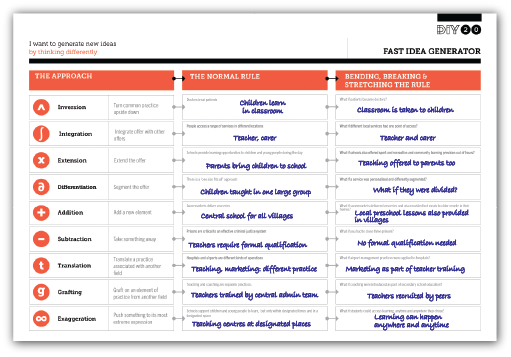3 Exploring a problem
To complete the Fast Idea Generator Template, start from an existing concept, problem or opportunity, and then apply the nine approaches suggested in the template. These are simple steps to help you to think of alternatives that bend, break and stretch the ‘normal rules’ in such a way that you can generate many surprising ideas in a short period of time.
It is important to remember that, in the first instance, you’re not looking for the ‘good’ or ‘right’ answers, but simply answers that are not constrained by convention. Of course, in reality, some of these will be inappropriate or even impossible to achieve, but selecting the good ideas comes at a later step in the fast idea generator process. This is the fun bit!
In Case Study 3 below, we follow Rikta’s use of the Fast Idea Generator Template. Rikta is a schoolteacher in rural India.
Case Study 3: Turning schools upside down?
Rikta is very passionate about education and wishes she could teach more children. Her nearest school is a long way from many of the local communities, making it difficult for children to attend. Many local children are also unprepared for school, as they’ve never experienced any sort of education. Rikta sees this as a big problem. She knows the existing education system could be improved to bring about better outcomes for people, but she doesn’t know how to make the change happen. To help her generate lots of ideas, Rikta uses the Fast Idea Generator Template. Hopefully this will help her to get a little closer to teaching more children in community schools.
Rikta applies the nine different approaches to challenge how the system currently works.
- She uses the inversion approach to turn the system ‘upside down’.
- She tries to combine some education and community services through the integration approach.
- Rikta wonders how to extend teaching to include other services as well.
- She uses the differentiation approach to look at ways of separating elements of the system.
- She considers whether any new features exist that can be added to schooling; she maps out a few opportunities.
- For the subtraction approach she takes away unnecessary elements of what currently happens in the system.
- Rikta uses the translation tactic to apply a new practice from another field.
- For grafting, she inserts something that works from another field and combines it with teaching.
- Finally Rikta uses exaggeration to try to push teaching to the extreme.
Rikta’s responses are shown in Figure 2.
Key point
Do not stop to question or challenge ideas while working with the Fast Idea Generator Tool. Have fun exploring a wide range of perspectives.
Activity 3
What are your thought about Rikta’s use of the Fast Idea Generator Template? Would you have had the same ideas? How do you think she could have done it better? Make some notes in the text box below.
Discussion
You might have had more ideas than Rikta – in fact, it’s likely that Rikta had lots of other ideas that didn’t get captured on the version of the Fast Idea Generator Template that she’s shared. She could, of course, have sought input from other people to broaden her thinking process – perhaps other teachers, parents and/or other interested members of the community.
2 Thinking differently

